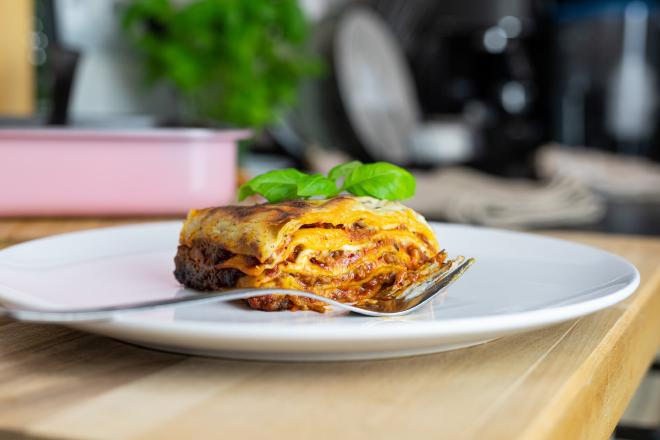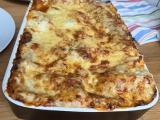Reference Recipe: Lasagna
Table of Contents
Jump to Recipe
Jump to Carbon Footprint
To give you a better idea of how climate-friendly different recipes are, I have used some reference recipes for comparison. These classic recipes are not necessarily the most climate-friendly, but serve as a benchmark for all other recipes. The following article is one of these reference recipes
There are many different types of lasagna, which use layers of sauce and pasta to create a delicious casserole. Probably the most common version uses Bolognese and béchamel sauces. Here is a simple recipe, with some vegetables in the Bolognese sauce.

Recipe #
Lasagna with minced beef
60 minutes
2 portions
With the different sauces and the rather long baking time, it probably makes sense to cook a little more than two portions.
Ingredients #
For the Bolognese sauce
- 1/2 small onion
- 1 clove garlic
- 1 tablespoon olive oil
- 240 g minced beef
- 1/2 small carrot
- 35 g celery (half a small stalk)
- 1 tablespoon tomato puree
- 300 ml red wine
- 275 ml canned tomatoes
- 1 tablespoon dried vegetable stock
- 1 teaspoon thyme
- 1 teaspoon oregano
- 1 teaspoon rosemary
- 2 g salt
- 2 g pepper
For the béchamel sauce
- 20 g butter
- 20 g flour
- 250 ml milk
- 1 pinch of salt
- 1 pinch of pepper
- 1 pinch of nutmeg
For the lasagna
- 80 g lasagna sheets
- about 60 g mozzarella
Directions #
- Chop the ingredients for the Bolognese sauce: Finely dice the onion, garlic, carrot, and celery.
- Prepare the Bolognese sauce: Brown the onion in olive oil, add the garlic after 2 minutes.
- When the onion is translucent, add the beef and cook until it is browned.
- Add the diced carrot, celery, and tomato puree and continue to fry.
- When the carrots, celery, and tomato puree have browned for about three minutes, add the red wine. Allow to reduce slightly, then add the canned tomatoes. Season to taste with salt, pepper, thyme, oregano, and rosemary, then cover and leave to simmer over low heat. Stir from time to time.
- While the Bolognese sauce is cooking, make the béchamel sauce: Heat the butter in a frying pan, then add the flour. Cook for 1-2 minutes, stirring gently with a whisk to prevent lumps forming.
- Slowly add the milk and whisk to form a sauce. Season to taste with salt, pepper, and nutmeg.
- Layer the lasagna in an ovenproof dish: Start with a layer of Bolognese sauce on the bottom. Then add the lasagna sheets, then the béchamel sauce, then another layer of Bolognese sauce. Continue layering until the top layer is once again the lasagna sheets with the béchamel sauce on top. Roughly slice the mozzarella and place on top.
- Bake in a fan oven at about 180°C for about 30-40 minutes. The lasagna will expand slightly as it bakes - so don’t layer it to the edge of the tin or it will overflow.
Carbon Footprint #
In total, two portions of lasagna have an estimated carbon footprint of 3988 g.
This ranks it number 55 out of 57 recipes published on the blog so far in terms of estimated carbon footprint.
In other words, it is one of the five recipes with the worst carbon footprint. 😱Of course, minced beef stands out among the ingredients: It accounts for more than half of the estimated carbon footprint, despite making up only about a quarter of the weight of the ingredients. Cheese also contributes disproportionately to emissions: Mozzarella accounts for around 5% of ingredient weight but 9% of CO2 emissions. Canned tomatoes and lasagna pasta, on the other hand, have a much better CO2 balance.
| ingredient | carbon footprint per kg | carbon footprint (in g) for 2 servings | % of ingredients | % of CO2 emissions |
|---|---|---|---|---|
| Onion | 0.2 | 7 | 3% | 0% |
| Garlic | 0.5 | 1 | 0% | 0% |
| Olive oil | 3.2 | 16 | 0% | 0% |
| Minced beef | 9.2 | 2208 | 22% | 55% |
| Carrots | 0.1 | 4 | 3% | 0% |
| Celery | 0.2 | 7 | 3% | 0% |
| Tomato puree | 4.3 | 22 | 0% | 1% |
| Red wine | 1.0 | 30 | 3% | 1% |
| Canned tomatoes | 1.8 | 495 | 25% | 12% |
| Vegetable stock | 1.4 | 4 | 0% | 0% |
| Thyme | 1.1 | 2 | 0% | 0% |
| Oregano | 1.1 | 2 | 0% | 0% |
| Rosemary | 1.1 | 2 | 0% | 0% |
| Salt | 1.4 | 3 | 0% | 0% |
| Pepper | 1.4 | 3 | 0% | 0% |
| Butter | 9.0 | 180 | 2% | 5% |
| Flour | 1.6 | 32 | 2% | 1% |
| Milk | 1.4 | 350 | 23% | 9% |
| Salt | 1.4 | 1 | 0% | 0% |
| Pepper | 1.4 | 1 | 0% | 0% |
| Nutmeg | 1.1 | 1 | 0% | 0% |
| Lasagna sheets | 0.7 | 56 | 7% | 1% |
| Mozzarella | 5.7 | 342 | 5% | 9% |
| Cook the Bolognese sauce (20 min) | 70 | 2% | ||
| Cooking béchamel sauce (7 min) | 4 | 0% | ||
| Bake lasagna (35 min) | 146 | 4% |


